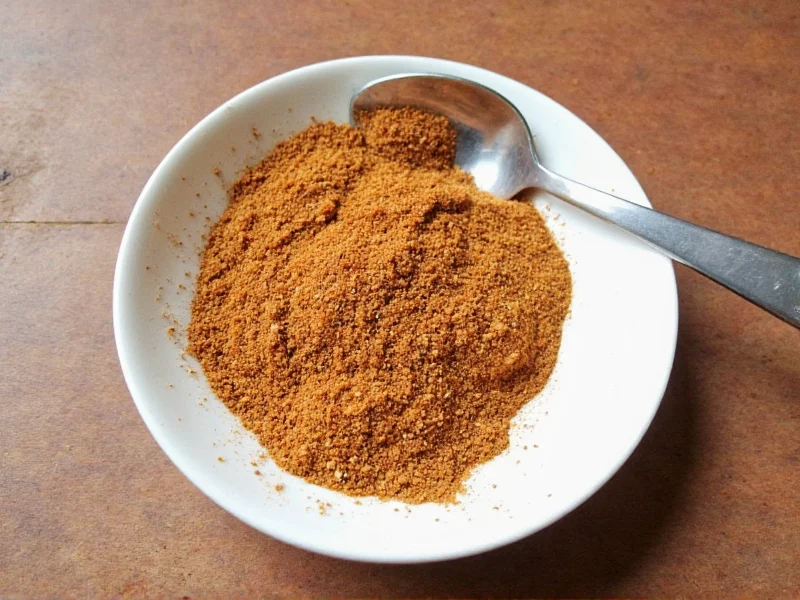Understanding Poultry Seasoning Composition
Poultry seasoning isn't a single standardized recipe but rather a traditional herb combination developed specifically to complement bird meats. The core ingredients remain remarkably consistent across most commercial and homemade versions:
| Primary Ingredient | Flavor Profile | Percentage in Blend |
|---|---|---|
| Sage | Earthy, slightly peppery | 30-40% |
| Thyme | Floral, minty undertones | 20-25% |
| Marjoram | Sweet, citrusy notes | 15-20% |
| Rosemary | Pine-like, robust | 10-15% |
| Black Pepper | Sharp, pungent heat | 5-10% |
Sage serves as the dominant flavor in most poultry seasoning blends, providing that distinctive earthy backbone familiar in traditional Thanksgiving stuffings. Thyme adds complexity while marjoram—often confused with oregano—contributes subtle sweetness. Rosemary appears in smaller quantities to avoid overwhelming the blend, and black pepper provides necessary heat balance.
Regional and Brand Variations
While the basic formula remains consistent, regional preferences influence poultry seasoning composition. New England blends often feature more sage and less rosemary, while Southern versions sometimes include a touch of red pepper flakes for subtle heat. Some premium brands add allspice or nutmeg for depth, though purists argue these belong only in specific regional stuffings.
When examining commercial poultry seasoning ingredients lists, check for fillers like salt, sugar, or anti-caking agents. High-quality blends contain only dried herbs, spices, and occasionally rice flour as an anti-caking agent. The best options list specific herb varieties rather than generic “spices.”
Practical Applications Beyond Poultry
Despite its name, poultry seasoning works wonderfully across multiple applications. Many home cooks discover its versatility extends far beyond turkey and chicken recipes:
- Vegetable roasting: Toss root vegetables with olive oil and poultry seasoning before roasting
- Gravy enhancement: Add 1-2 teaspoons to pan drippings for richer flavor
- Stuffing foundation: The essential base for traditional bread stuffing
- Soup seasoning: Improves chicken-based soups and stews
- Vegetarian dishes: Adds savory depth to mushroom risotto or lentil loaves
For optimal results, add poultry seasoning early in the cooking process to allow flavors to meld, but avoid excessive cooking which diminishes the delicate herbal notes. When using in dry rubs, combine with salt and olive oil to help the herbs adhere to the protein surface.
Creating Your Own Custom Blend
Homemade poultry seasoning gives you complete control over freshness and ingredient quality. This basic recipe yields approximately 1/4 cup:
- Combine 2 tablespoons dried rubbed sage
- Add 1.5 tablespoons dried thyme
- Mix in 1 tablespoon dried marjoram
- Incorporate 2 teaspoons dried rosemary (crushed between fingers)
- Stir in 1.5 teaspoons freshly ground black pepper
- Optional: Add 1/4 teaspoon ground nutmeg for holiday recipes
Store your homemade poultry seasoning in an airtight container away from light and heat. Properly stored, it maintains peak flavor for 6-8 months. For maximum freshness, grind whole dried herbs using a dedicated spice grinder just before mixing your blend.
Effective Substitutes When You're Out
Rather than making a special store trip, try these practical poultry seasoning substitute options:
- Herb triad: Equal parts sage, thyme, and marjoram (most accurate substitute)
- Italian seasoning plus sage: 2 parts Italian seasoning to 1 part extra sage
- Herbes de Provence alternative: Add extra sage to standard herbes de Provence
- Individual herb approach: 1/2 tsp sage + 1/4 tsp thyme + 1/4 tsp marjoram per teaspoon needed
When substituting, remember that sage provides the characteristic flavor profile, so never eliminate it completely from your substitute blend. Adjust quantities based on your specific recipe—stronger herbs like rosemary should appear in smaller amounts to avoid overpowering delicate poultry dishes.
Common Misconceptions Clarified
Several myths persist about poultry seasoning that deserve clarification. First, despite the name, no poultry products appear in the blend—it's purely herbs and spices designed for poultry. Second, poultry seasoning differs significantly from poultry rubs, which typically contain salt, sugar, and additional spices for surface application rather than cooking integration.
Many cooks mistakenly believe poultry seasoning works only with turkey and chicken. In reality, its balanced herbal profile complements pork loin, mushroom dishes, and even some vegetarian applications where savory depth is needed. The blend's versatility makes it one of the most useful pantry staples beyond its namesake purpose.
Frequently Asked Questions
What's the difference between poultry seasoning and poultry rub?
Poultry seasoning is a pure herb blend without salt, designed to be incorporated into dishes during cooking. Poultry rubs typically contain salt, sugar, and additional spices specifically formulated for surface application before cooking.
Can I use poultry seasoning in vegetarian dishes?
Absolutely. Poultry seasoning works well in vegetarian applications like mushroom risotto, lentil loaves, roasted root vegetables, and vegetable-based stuffings. Its herbal profile adds savory depth without meat products.
How much poultry seasoning should I use per pound of meat?
For most poultry dishes, use 1 to 1.5 teaspoons of poultry seasoning per pound of meat. When incorporating into stuffings or gravies, start with 1 teaspoon per cup of base ingredient and adjust to taste.
Does poultry seasoning contain actual poultry?
No commercial poultry seasoning contains any poultry products. The name refers to its intended use with poultry dishes, not its ingredients, which consist solely of dried herbs and spices.











 浙公网安备
33010002000092号
浙公网安备
33010002000092号 浙B2-20120091-4
浙B2-20120091-4